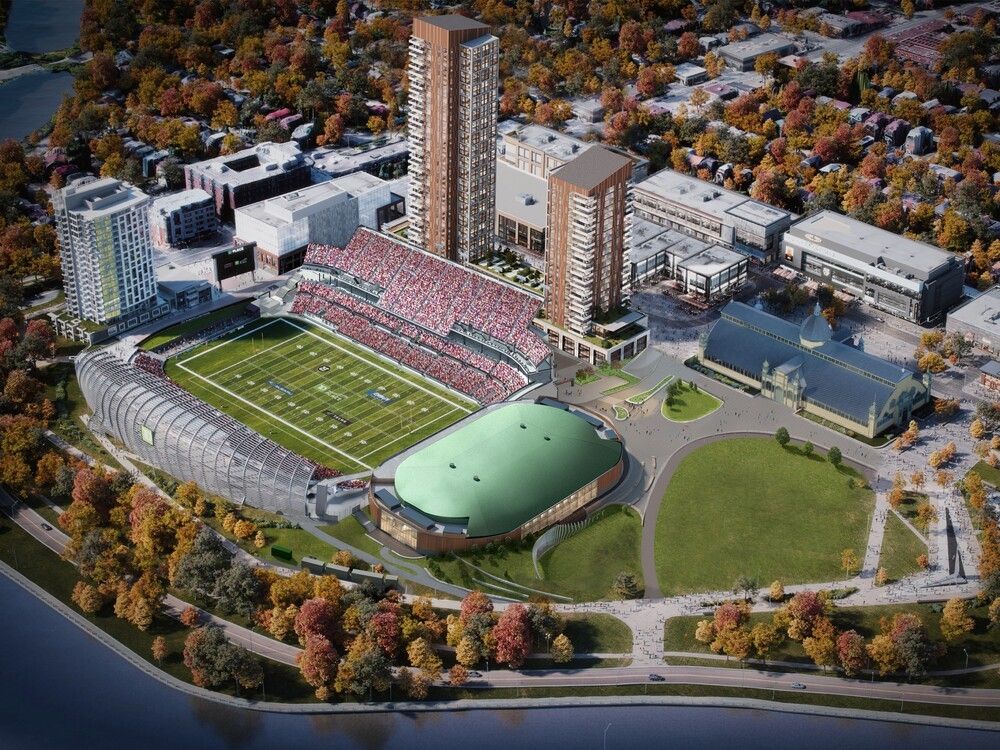Opponents of the
Lansdowne 2.0 redevelopment
lined up to voice their concerns over the project’s long-term financial risks, the
complexity of the contract
, the city’s shortage of contingency funds and the
likelihood of cost overruns
.
The city held a marathon two-day committee meeting last week that saw dozens of people sign up to speak in delegations that featured proponents and opponents of the lengthy deal with the Ottawa Sports and Entertainment Group.
Several of the outspoken opponents reconvened this week at a Better Ottawa public forum in Barrhaven hosted by Neil Saravanamuttoo and Capital ward Coun. Shawn Menard — both among the fiercest critics of the deal — and are expected to gather once again outside City Hall on Friday in advance of the special council meeting that will put Lansdowne 2.0 to a vote.
Several more spoke out against the project at the Nov. 4 audit committee, where Auditor General Nathalie Gougeon flagged risks of construction delays, the city’s minimal 10 per cent contingency budget and the potential for cost overruns that would be borne by the taxpayer.
Gougeon said the greatest risk associated with the project is the potential for cost overruns.
“Every dollar in excess is a dollar that the city is responsible for covering, and, in turn, will be a cost the taxpayer is indirectly covering as well,” she said.
Carolyn Mackenzie, planning chair with the Glebe Community Association and a member of the city’s planning advisory committee, said the city would likely need to increase its contingency budget from 10 per cent to 25 per cent to cover any “unexpected events, risks or changes” that may arise, as identified in Gougeon’s report.
“The 10 per cent cost contingency is obviously a very minimal buffer,” Mackenzie said, echoing the auditor general’s assessment.
An increase to the suggested 25 per cent contingency fund would increase costs by $50 million, Mackenzie said, or roughly $2.5 million a year in debt service costs.
Mackenzie said the construction bidding process was “clearly rushed” considering the complexities of the project.
The tender was awarded to construction firm EBC Inc., who the city said offered the “best value bid” of $312.8 million to build the north-side stands and the new hockey arena and event centre.
“Bidders asked 1,500 questions during the bid phase,” Mackenzie said. “This is an eye-popping number of questions, indicating a tremendous lack of clarity in documents and should be a huge red flag. It indicates a bid released in a hurry and an overly-complicated procurement.”
Mackenzie said that likely carries a risk of future litigation and “significant” additional costs.
Mackenzie, like many of those opposed to Lansdowne 2.0, invoked comparisons to the city’s decade-long, multi-billion-dollar light-rail contract.
“What I worry about with this project is that we are going to have the same experience we had with the LRT,” said Saravanamuttoo. “We said ‘fixed budget’ and we got a set price of $2.1 billion — in this case (of Lansdowne 2.0) $419 million…. We made all kinds of sacrifices that got us below that ceiling, but caused operational problems going forward.
“What I worry about is that as soon as shovels are in the ground, the contractor is going to come back to the city with change orders.”
Noel Lomer, a retired investment advisor, warned the Landsdowne project has high risks, “both due to the economy facing Ottawa and due to the project’s financial risks, which could terminate the project.”
Lomer cited Canada’s slowing economy and declining GDP, rising inflation and worsening market conditions, a slowing real estate market and cuts to the federal public service impacting the national capital region’s largest employer.
“Now is not the time to commit a minimum of a half a billion dollars on a sports and entertainment complex. It’s time to be prudent, not adventurous,” Lomer told councillors, flagging “serious financial risks” with Lansdowne 2.0 and an unpredictable economic future with a deal that extends to 2075.
“Total cost of major infrastructure projects always grows,” he said. “The LRT costs have been much greater than planned and the new library, as an example, is 73 per cent over budget.
“The stadium and arena contract is not a fixed price contract when taxpayers are on the hook for cost overruns,” Lomer said, and relying on revenue sources like ticket surcharges, property tax uplift, waterfall distributions and retail profits “are very high risk.”
A Nov. 6 memo from city general manager Wendy Stephanson sought to “clarify” the numbers presented in the Lansdowne 2.0 plan on the eve of the final council vote.
If the proposal is approved, the city will have access to “new and site-specific revenue sources that would not materialize if the project were not to proceed and, therefore, would not be available for other city services or projects,” Stephanson wrote.
The $418.8 million cost for the new north-side stands, “grand entrance” and event centre will be paid for by $33.9 million in the sale of air rights, $32.4 million in debt premiums, $6 million from the Municipal Accommodation Tax, $15.6 million in city capital reserves and $331 million in additional debt over the span of the project, the memo states.
“The city’s true cost is the contribution from reserves, the debt premium and only $82.7 million of the debt for a total of $130.7 million. The remaining $248.3 million in debt will be offset by other revenues.”
Once those other sources of revenue are taken into account, Stephanson said, the true cost to taxpayers is $4.3 million annually.
Those revenues would not otherwise be available for any other city service or renewal project, she wrote.
Maintaining Lansdowne Park as-is under the terms of the 2012 Lansdowne 1.0 deal “is not feasible and is not the direction given by council,” Stephanson wrote.
The old Civic Centre arena, built in 1967, is the second-oldest municipal arena in the province, and while both the arena and north-side stands are structurally sound, they are “functionally obsolete and no longer operationally suited to the requirements or expectations of modern event organizers, athletes, performers, or guests.”
Stephanson cited many of the “challenges” with the stands and the arena that were identified by proponents of Lansdowne 2.0 during the lengthy public delegations last week, including outdated lighting and sound systems, the lack of proper HVAC and dehumidifying capacity, limited rigging and load-bearing capacity, insufficient entertainer and athlete dressing rooms, lack of premium seating and accessibility barriers throughout the facility.
“These constraints affect both the range and scale of events that can be hosted in Ottawa,” Stephanson wrote, and have been cited by national and international event organizers as “barriers to hosting major events in the city.”
Stephanson said city staff have heard critiques that the half-billion-dollar investment could be better spent on other priorities, but said, “This is not an accurate interpretation of the business case put forward for council’s consideration.”
— With files from Joanne Laucius
Related
- Lansdowne 2.0 project carries risk from ‘unforeseen costs,’ AG says
- Here’s what you need to know about the complex financing of the Lansdowne 2.0 deal



